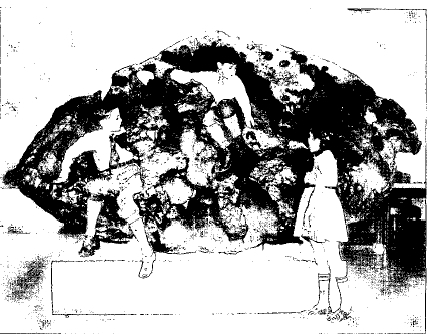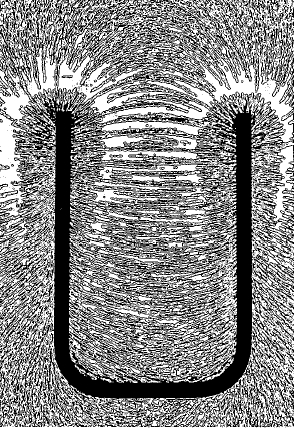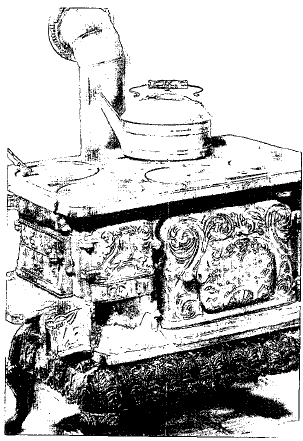

The period in human history beginning in about 1200 B.C. is called the Iron Age. It was at about this time that humans first learned how to use iron metal. But in some ways, one could refer to the current era as the New Iron Age. Iron is probably the most widely used and most important metal today. No other metal is available to replace iron in all its many applications.
Iron is a transition metal. The transition metals are the elements that make up Groups 3 through 12 in the periodic table. The periodic table is a chart that shows how elements are related to one another. The transition metals are typical metals in that they tend to be bright, shiny, silvery solids. They all tend to conduct heat and electricity well. And they usually have high melting points.
ATOMIC NUMBER
26
ATOMIC MASS
55.847
FAMILY
Group 8 (VIIIB)
Transition metal
PRONUNCIATION
EYE-um
Iron normally does not occur as a free element in the earth. In fact, iron was not of much value to humans until they learned how to free iron from its compounds. Once they could do that, humans were able to make tools, weapons, household implements, and other objects out of iron. This step marked the beginning of the Iron Age.

Some meteorites are very rich in iron. Here, children play on the Williamette meteorite in Hayden Planetarium in New York City, in 1939.
Iron is most valuable not as a pure metal, but in alloys. An alloy is made by melting and mixing two or more metals. The mixture has properties different from those of the individual metals. The best known and most widely used alloy of iron is steel. Steel contains iron and at least one other element. Today, specialized steels of all kinds are available for many different applications.
Ancient Egyptians had learned how to use iron before the First Dynasty, which began in about 3400 B.C. The Egyptians probably found the iron in meteorites. Meteorites are chunks of rock and metal that fall from the sky. Some meteorites are very rich in iron. The Egyptians made tools and jewelry out of iron.
Iron is probably the most widely used and most important metal today.
Iron was also known to early Asian civilizations. In Delhi, India, for example, a pillar made out of iron built in A.D. 415 still stands. It weighs 6.5 metric tons and remains in good condition after nearly 1,600 years.
Early Chinese civilizations also knew about iron. Workers learned to produce iron as early as 200 B.C. A number of iron objects, including cannons, remain from the Han period (202 B.C. to A.D. 221).
The Bible also includes many mentions of iron. For example, a long passage in the book of Job describes the mining of iron. Other passages tell about the processing of iron ore to obtain iron metal.
By the time of the Roman civilization, iron had become an essential metal. The historian Pliny (A.D. 23-79) described the role of iron in Rome:
It is by the aid of iron that we construct houses, cleave rocks, and perform so many other useful offices of life. But it is with iron also that wars, murders, and robberies are effected, and this, not only hand to hand, but from a distance even, by the aid of weapons and winged weapons, now launched from engines, now hurled by the human arm, and now furnished with feathery wings.
Even from the earliest days, humans probably seldom used iron in a pure form. It was difficult to make iron that was free of impurities, such as carbon (charcoal) and other metals. More important, however, it became obvious that iron with impurities was a stronger metal that iron without impurities.
It was not until 1786, however, that scientists learned what it was in steel that made it a more useful metal than iron. Three researchers, Gaspard Monge (1746-1818), C. A. Vandermonde, and Claude Louis Berthollet (1748-1822) solved the puzzLe. They found that a small amount of carbon mixed with iron produced a strong alloy. That alloy was steel. Today, the vast amount of iron used in so many applications is used in the form of steel, not pure iron.
Ancient Egyptians had learned how to use iron before the First Dynasty, which began in about 3400 B.C.
The chemical symbol for iron is Fe. That symbol comes from the Latin name for iron, ferrum.
Iron is a silvery-white or grayish metal. It is ductile and malleable. Ductile means capable of being drawn into thin wires. Malleable means capable of being hammered into thin sheets. It is one of only three naturally occurring magnetic elements. The other two are nickel and cobalt
Iron has a very high tensile strength. Tensile means it can be stretched without breaking. Iron is also very workable. Workability is the ability to bend, roll, hammer, cut, shape, form, and otherwise work with a metal to get it into a desired shape or thickness.
The melting point of pure iron is 1,536°C (2,797°F) and its boiling point is about 3,000°C (5,400°F). Its density is 7.87 grams per cubic centimeter. The melting point, boiling point, and other physical properties of steel alloys may be quite different from those of pure iron.
Iron is a very active metal. It readily combines with oxygen in moist air. The product of this reaction, iron oxide (Fe 2 O 3 ), is known as rust. Iron also reacts with very hot water and steam to produce hydrogen gas. It also dissolves in most acids and reacts with many other elements.
Iron is the fourth most abundant element in the Earth's crust. Its abundance is estimated to be about 5 percent. Most scientists believe that the Earth's core consists largely of iron. Iron is also found in the Sun, asteroids, and stars outside the solar system.
The most common ores of iron are hematite, or ferric oxide (Fe 2 O 3 ); limonite, or ferric oxide (Fe 2 O 3 ); magnetite, or iron oxide (Fe 3 O 4 ); and siderite, or iron carbonate (FeCO 3 ). An increasingly important source of iron is taconite. Taconite is a mixture of hematite and silica (sand). It contains about 25 percent iron.
The largest iron resources in the world are in China, Russia, Brazil, Canada, Australia, and India. The largest producers of iron from ore in the world are China, Japan, the United States, Russia, Germany, and Brazil.

Iron is one of only three naturally occurring magnetic elements. This is a computer graphic of a horseshoe magnet with iron filings aligned around it.
There are four naturally occurring isotopes of iron, iron-54, iron-56, iron-57, and iron-58. Isotopes are two or more forms of an element. Isotopes differ from each other according to their mass number. The number written to the right of the element's name is the mass number. The mass number represents the number of protons plus neutrons in the nucleus of an atom of the element. The number of protons determines the element, but the number of neutrons in the atom of any one element can vary. Each variation is an isotope.
Six radioactive isotopes of iron are known also. A radioactive isotope is one that breaks apart and gives off some form of radiation. Radioactive isotopes are produced when very small particles are fired at atoms. These particles stick in the atoms and make them radioactive.
Two radioactive isotopes of iron are used in medical and scientific research. They are iron-55 and iron-59. These isotopes are used primarily as tracers in studies on blood. A tracer is a radioactive isotope whose presence in a system can easily be detected. The isotope is injected into the system. Inside the system, the isotope gives off radiation. That radiation can be followed by detectors placed around the system. Iron-55 and iron-59 are used to study the way in which red blood cells develop in the body. These studies can be used to tell if a person's blood is healthy.
Iron goes through a number of stages between ore and final steel product. In the first stage, iron ore is heated with limestone and coke (pure carbon) in a blast furnace. A blast furnace is a very large oven in which the temperature may reach 1,500°C (2,700°F). In the blast furnace, coke removes oxygen from iron ore:
The limestone removes impurities in the iron ore.
Iron produced by this method is about 91 to 92 percent pure. The main impurity left is carbon from the coke used in the furnace. This form of iron is known as pig iron. Pig iron is generally too brittle (it breaks too easily) to be used in most products.
Most scientists believe that the Earth's core consists largely of iron.
A number of methods have been developed for purifying pig iron. A common method used today is called the basic oxygen process. In this process, pig iron is melted in a large oven. Then pure oxygen gas is blown through the molten pig iron. The oxygen burns off much of the carbon in the pig iron:

Although now outdated, iron stoves were once the primary source of heat for homes, as well as a means for cooking.
A small amount of carbon remains in the iron. The iron produced in this reaction is known as steel.
The term "steel" actually refers to a wide variety of products. The various forms of steel all contain iron and carbon. They also contain one or more other elements, such as silicon, titanium, vanadium, chromium, manganese, cobalt, nickel, zirconium, molybdenum, and tungsten. Two other steel-like products are cast iron and wrought iron. Cast iron is an alloy of iron, carbon, and silicon. Wrought iron contains iron and any one or more of many other elements. In general, however, wrought iron tends to contain very little carbon.
It would be impossible to list all uses of iron and steel products. In general, those products can be classified into categories: (1) automotive; (2) construction; (3) containers, packaging, and shipping; (4) machinery and industrial equipment; (5) rail transportation; (6) oil and gas industries; (7) electrical equipment; and (8) appliances and utensils. (For more information on specific kinds of steel alloys, see individual elements, such as titanium, vanadium, chromium, manganese, molybdenum, and tungsten.)
Some iron is made into compounds. The amount is very small compared to the amount used in steel and other iron alloys. Probably the fastest growing use of iron compounds is in water treatment systems. The terms ferric and ferrous refer to two different forms in which iron occurs in compounds. Some of the important iron compounds are:
The U.S. Recommended Daily Allowance (USRDA) for iron is 18 milligrams.
ferric acetate (Fe(C 2 H 3 O 2 ) 3 ): used in the dyeing of cloth
ferric ammonium oxalate(Fe(NH 4 ) 3 (C 2 O 4 ) 4 ): blueprints
ferric arsenate (FeAsO 4 ): insecticide
ferric chloride (FeCl 3 ): water purification and sewage treatment systems; dyeing of cloth; coloring agent in paints; additive for animal feed; etching material for engraving, photography, and printed circuits
ferric chromate (Fe 2 (CrO 4 ) 3 ): yellow pigment (coloring) for paints and ceramics
ferric hydroxide (Fe(OH) 3 ): brown pigment for coloring rubber; water purification systems
ferric phosphate (FePO 4 ): fertilizer; additive for animal and human foods
ferrous acetate (Fe(C 2 H 3 O 2 ) 2 ): dyeing of fabrics and leather; wood preservative
ferrous gluconate (Fe(C 6 H 11 O 7 ) 2 ): dietary supplement in "iron pills"
ferrous oxalate (FeC 2 O 4 ): yellow pigment for paints, plastics, glass, and ceramics; photographic developer
ferrous sulfate (FeSO 4 ): water purification and sewage treatment systems; catalyst in production of ammonia; fertilizer; herbicide; additive for animal feed; wood preservative; additive to flour to increase iron levels
Iron is of critical importance to plants, humans, and animals. It occurs in hemoglobin, a molecule that carries oxygen in the blood. Hemoglobin picks up oxygen in the lungs, and carries it to the cells. In the cells, oxygen is used to produce energy the body needs to survive, grow, and stay healthy.
The U.S. Recommended Daily Allowance (USRDA) for iron is 18 milligrams. The USRDA is the amount of an element that a person needs to stay healthy. Iron is available in a number of foods, including meat, eggs, and raisins.
An iron deficiency (lack of iron) can cause serious health problems in humans. For instance, hemoglobin molecules may not form in sufficient numbers. Or they may lose the ability to carry oxygen. If this occurs, a person develops a condition known as anemia. Anemia results in fatigue. Severe anemia can result in a lowered resistance to disease and an increase in heart and respiratory (breathing) problems. Some forms of anemia can even cause death.